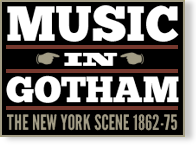Mollenhauer Conservatory Matinee: 2nd
Event Information
Venue(s):
Mollenhauer Conservatory [until 6/67]
Event Type:
Chamber (includes Solo)
Record Information
Status:
Published
Last Updated:
23 May 2016
Performance Date(s) and Time(s)
10 Oct 1866, 2:00 PMPerformers and/or Works Performed
Citations
“The classic matinees inaugurated by Mr. Edward Mollenhauer, at his handsome Conservatory Hall in Schuberth’s on Broadway, have proved a decided success and they are worthy of the attention of every musician. Yesterday the second one took place. The programme brought in Beethoven, Schumann and Schubert and the unclassical Balfe. Of the Beethoven pieces the only one we heard was his sonata in G minor, which was played by a pupil of the Conservatory, Miss Emily Kohl. If she is a proof of the efficiency and excellence of Mr. Mollenhauer’s Conservatory, then we must heartily commend it to the public. Here was a little girl only eight years of age, and but a year a pupil of the Conservatory, playing a piece by Beethoven in even endurable style. Every note was correct and the phrasing and conception in general far better than we have heard from some who appear frequently in concerts. Of course it could not be expected that she would be able to play Beethoven as his simplest demand, but for so young a pianist she was a phenomenon. Another pupil of the Conservatory, Miss Florence Rosenberg, also did credit to that institution. She sang a gypsy’s song, by Balfe, very well for an amateur, and showed that with her good natural voice she will become, after more training and instruction, a by no means mediocre singer in the concert room. Messrs. H. Mollenhauer and R. Herring played a Nocturne Eligiaque [sic], by Schubert. Both deserve praise for the perfect ensemble of the instruments, and their clearness and purity of tone in even the fortissimo passages. But there was entirely too much breadth and loudness of tone for such a subject. They treated it more like a nocturne in which there was a midnight attack than that tender, lulling theme which Schubert evidently intended it to be. The finale of the matinee was a quintette for two violins, viola, violoncello and piano by Schumann. It is a complicated and very difficult piece, but lacks completeness and even intelligibility. Not but that there are some beautifully plaintive, Schumann passages in it; but they serve only to excite attention and interest in the development of the composer’s idea. When you arrive at the end there is an unsatisfied feeling, as if all that went before was some insoluble problem, to be explained only by the composer. It was played by Messrs. Edward Mollenhauer, J. Zeiss, Bernard and Henry Mollenhauer and J. N. Pattison. The latter did full justice to the abstruse piano score, and served as an excellent foil to the strings which break in fugue-like waves against the heavy piano, massing that rises like bold headlands at the end of every half-dozen measures. This work of Schumann must certainly be an unfinished one, for it seems like an introduction to some tone poem of his. His gloomy, sad spirit is shown in it as much as in any of his other works. The two pianos used at the matinee, a grand and square, were very different from the wretched Leipsic affair, introduced at the first matinee. They were trustworthy mediums for interpreting the works of any author. While we have such excellent American instruments there is not the slightest use in inflicting on an intelligent American public fifth rate European and disant pianos. The next matinee will take place on the 24th inst. at the Conservatory Hall.”
The event was very well attended mostly by students of the conservatory. The performance of some of the students was acceptable. Pattison played on one of the smaller Steinway grand pianos which is perfectly suited for smaller recital halls.

